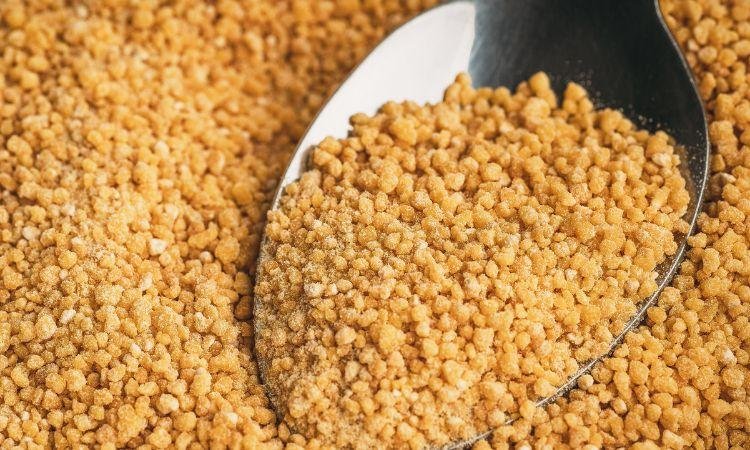The global lecithin market size reached a volume of 418.9 thousand metric tons (KMT) in 2023. The market is estimated to grow at a steady clip, with a projected Compound Annual Growth Rate (CAGR) of 3.8% during 2024-2032, reaching a volume of 584.6 KMT by 2032. This significant growth reflects the rising demand for lecithin, a natural emulsifier and functional food ingredient, across various food processing applications.
This blog post delves into the fascinating world of lecithin, exploring its diverse roles in the food industry. We'll begin by understanding lecithin's fundamental properties and its significance as an emulsifier. We'll then explore its various applications, from creating stable emulsions in salad dressings to enhancing the texture of baked goods. We'll also delve into the lesser-known functionalities of lecithin and its impact on food quality, shelf life, and sustainability. Finally, we'll peek into the future, exploring potential advancements in lecithin technology and emerging trends in its use within novel food products.
Emulsification and Beyond: Unveiling the Power of Lecithin in Food
Lecithin, a naturally occurring group of phospholipids, plays a vital role in the food industry. Derived from soybeans, sunflowers, or egg yolks, lecithin possesses unique amphiphilic properties. This means it has both water-loving (hydrophilic) and fat-loving (lipophilic) ends. This special characteristic allows lecithin to act as an excellent emulsifier, enabling the efficient blending of otherwise immiscible ingredients like oil and water.
Emulsions are a fundamental aspect of many popular food products. They play a crucial role in creating the smooth texture of chocolate, the creamy consistency of mayonnaise, and the stability of salad dressings. Lecithin, with its exceptional emulsifying ability, facilitates the formation and stabilization of these emulsions, ensuring a desirable texture and mouthfeel in the final product.
Demystifying Emulsions: The Magic of Lecithin
Let's take a closer look at emulsions and how lecithin functions as their guardian angel. An emulsion is a mixture of two or more immiscible liquids, where one liquid is dispersed as tiny droplets within the other. For example, oil and water naturally separate due to their opposing polarities. Lecithin, with its dual personality, acts as a bridge between these two worlds. The hydrophilic end of lecithin interacts with water molecules, while the lipophilic end interacts with oil molecules. This creates a thin film around the oil droplets, preventing them from coalescing (clumping together) and ensuring a stable emulsion.
The effectiveness of lecithin as an emulsifier is attributed to several factors. First, its amphiphilic nature allows it to readily absorb onto the surface of oil droplets. Second, lecithin possesses a low interfacial tension, which reduces the resistance between the oil and water phases, facilitating their efficient mixing. Finally, lecithin molecules have a slight electrostatic charge, further contributing to the repulsion between oil droplets and maintaining emulsion stability.
A Culinary Chameleon: Lecithin's Diverse Applications in Food
Lecithin's emulsification prowess extends far beyond salad dressings. Here are some prominent examples of its versatility in the food industry:
- Chocolate and Confectionery: Lecithin helps create smooth, silky chocolate by preventing the cocoa butter and sugar from separating. It also plays a role in fat bloom reduction, ensuring a visually appealing and shelf-stable product.
- Margarine and Spreads: Lecithin facilitates the emulsification of water and fat in margarine, resulting in a spreadable consistency. It also helps bind air into the product, creating a light and fluffy texture.
- Baked Goods: Lecithin enhances dough handling properties by strengthening gluten and improving machinability. It also aids in even distribution of fat throughout the dough, leading to a more consistent rise and crumb structure in the final baked product.
- Dairy Products: Lecithin promotes even distribution of fat in ice cream, preventing ice crystal formation and ensuring a smooth texture. It also helps stabilize dairy foams in whipped cream and cappuccinos.
- Salad Dressings and Sauces: As mentioned earlier, lecithin plays a crucial role in creating stable emulsions in salad dressings, preventing oil separation and ensuring a consistent creamy texture.
Beyond the Emulsion: Unveiling Lecithin's Hidden Talents
While lecithin excels as an emulsifier, its functionalities extend far beyond. Here are some lesser-known applications of lecithin in food processing:
- Dispersing Agent: Lecithin's ability to interact with both water and oil makes it an excellent dispersing agent. It helps prevent clumping and promotes even distribution of powdered ingredients in food products like instant beverages, cocoa mixes, and powdered soups. By coating the individual particles, lecithin ensures a smooth and consistent mouthfeel upon reconstitution.
- Release Agent: Lecithin's ability to form a non-stick film makes it a valuable release agent in baking applications. It prevents cakes, cookies, and bread from sticking to baking pans, facilitating easier removal and promoting a clean presentation. In confectionery, lecithin aids in the release of candies from molds, ensuring smooth and well-defined shapes.
Future Trends: Lecithin Innovation and Novel Food Applications
The lecithin market is constantly evolving, with ongoing research exploring new functionalities and applications for this versatile ingredient. Here are some potential future trends to watch:
- Lecithin Technology Advancements: Research is underway to develop lecithins with tailored properties for specific food applications. This could involve modifying lecithin molecules to enhance their emulsifying power, dispersibility, or other functionalities.
- Novel Food Applications: Lecithin's potential extends beyond conventional food products. Its ability to form emulsions and stabilize dispersions makes it a valuable ingredient in the development of plant-based alternatives to meat, dairy, and egg products. Lecithin can contribute to creating realistic textures and mouthfeels in these novel food options.


